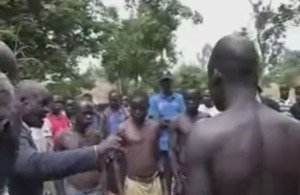The Acholi Religious Leaders Peace Initiative (ARLPI), a local interfaith peacebuilding organisation in northern Uganda, has urged Invisible Children to work with people in the region to find a lasting solution to the LRA situation.
An interview with Bishop Ochola from the APLPI.
The organisation championed the enactment of the Amnesty Act of 2000 in Uganda to pardon those who renounced insurgency and returned home. As a result of the act over 16,000 former LRA fighters, including senior commanders, have put down their weapons and have been reintegrated back into society.
The organisations patience with both Kony and Museveni in the past has also led to the Juba Peace Talks which ended hostilities within northern Uganda and paved the way for the return of over 2.1 million civilians forced from their homes during a decade of conflict.
The members of ARLPI have slept at the public bus parks and street verandas with the children depicted in Kony 2012.They have trekked hundreds of miles into the thick forest of Garamba in search of LRA leaders to find peaceful solutions to the conflict. They were and continue to be aware of the suffering going on in the Central African Republic and DR Congo. They have experienced this conflict first hand and know well the history and context of the situation and have a sophisticated understanding how a solution might look.
It is understandable that in light of these achievements and experiences and as one of the most respected voices of peace on the ground that the ARLPI received many phone calls and inquiries about the Kony 2012 video after it appeared.
Accordingly, as the dust settles over Invisible Children's Kony 2012 video, one thing remains clear to local peacebuilders in Uganda: the need to work together to effectively end the prolonged LRA insurgency.
It is a fact that the LRA conflict rages on, and urgent and immediate attention is required to bring the conflict to an end. To that effect, everyone agrees with Invisible Children. Even the harshest critics of the video agree that 26 years - and counting – is an unacceptable time for this insurgency to have been occurring and that together we must find a lasting solution.
It is in this context that ARLPI sent an open letter to Invisible Children, with the following messages:
- Invisible Children should push for revival of the peace talks that stalled in Juba, because there is no purely military solution to the LRA threat and impact.
- Invisible Children should learn more about the conflict and to talk to more people affected - including those who might not share their confidence in a military solution.
- Such campaigns should be launched in the affected region with full information of current conflict trends. Invisible Children should help to get their voice and those of their brothers and sisters in South Sudan, DR Congo and Central African Republic heard.
- As an NGO Invisible Children should play a neutral role in a military conflict.
- Since Invisible Children has been so successful in raising funds in the name of the victims of the LRA violence, it would be good share these resources with partner organisations on the ground struggling to respond to the situation.
While the result of these factors was that as the video went viral, criticism too spread like wildfire. In the midst of this whirlwind, some commentators lost their emotions, others hauled insults, some called names and many rubbished the good intentions and work already done by Invisible Children. While other international actors got ridiculed (talk about collateral damages) for having good intentions to do what they could to end human suffering wherever it is taking place.
In this mix, we all lost our objectivity and could not appreciate how simple and effective this campaign had been - it certainly made Kony famous. We all fell into the same trap as Invisible Children. We could not see past classifying Invisible Children in this equation as ‘bad’ –which after all, is the approach we’re criticising Invisible Children for in the first place. At the end of the day we all fell short as peacebuilders.
And yet, many of the critics did not even take time to watch the video before coming down on Invisible Children. While much of the criticism was well deserved, some was based on hearsay as few people, at least locally, had watched the actual video (given internet problems in Uganda) the local TV stations only played the first few minutes of the 30 minute documentary.
In Lira district, one of the districts most affected by the conflict a local NGO, AIYNET, decided to conduct a public screening of Kony 2012 to sensitise the community about the film. However the film was disrupted before it could finish by angry youths who did not want to watch the video. These young people were furious that it was a misrepresentation, a money making venture and was trivialising their suffering. Indeed, Kony 2012 had plunged the world into a conflict-like confusion.
The lessons learnt from Kony 2012 for me and those which I believe should be taken up by Invisible Children are that in a conflict situation, mistakes abound and nothing is black and white.
Just as some soldiers shoot shadows and others fire at civilians, others are just trigger happy and shoot at anything that crosses their path and there are even those who shoot first and aim later. This unfortunately is what takes place during a war - there is no simple answer.
It is therefore very unfortunate that a military solution was only strategy that Kony 2012 could call for. I would like to see Kony 2013 with these lessons learnt.









